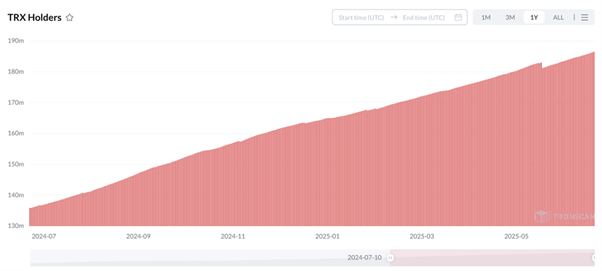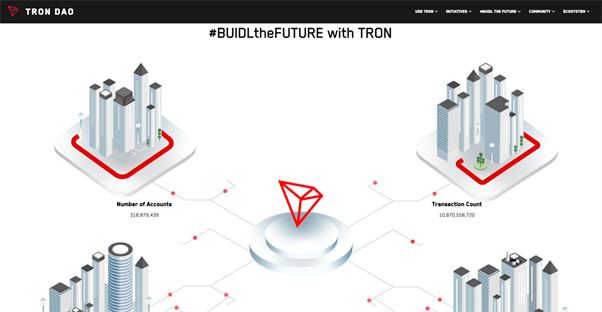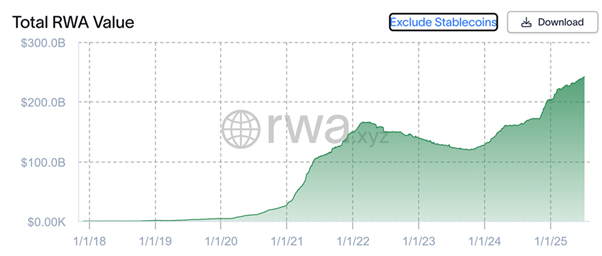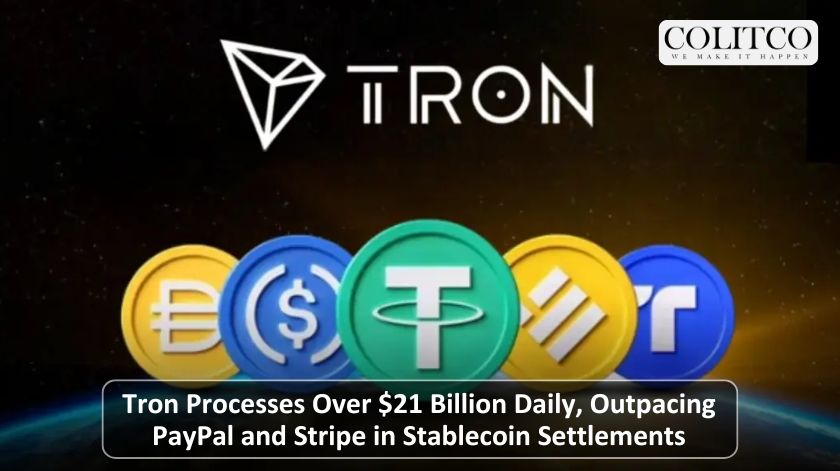TRX Network Handles Trillions in Value Annually
Tron continues to establish itself as one of the most used Layer-1 blockchains. The platform currently supports over 318 million accounts and facilitates over $19.6 trillion in cumulative on-chain volume. More than 186 million accounts actively hold its native token, TRX.
Daily transactions on the network exceed 1 million. Most of the volume is driven by USDT, which sees more than $22 billion transferred daily on Tron. The network handles nearly triple the daily stablecoin activity of Ethereum.

Launched for Content Creators, Pivoted to dApps
Justin Sun launched Tron in July 2017 with the aim to empower content creators. Tron’s mainnet went live in May 2018, marking the beginning of its Layer-1 presence.
Sun’s original plan was to remove intermediaries like streaming services. He envisioned a decentralised platform where creators were paid directly by consumers in TRX. However, the content sharing model did not gain momentum.
In 2018, the Tron Foundation acquired BitTorrent to accelerate data sharing. Later, the project transitioned into a platform for building decentralised applications. In 2021, Tron decentralised fully and restructured as the Tron DAO, now governed by the community through smart contracts.

Tron was launched with the aim of empowering content creators
Architecture and Functionality Power the Network
Tron is EVM-compatible and designed for high-throughput smart contracts. It uses a Delegated Proof of Stake (DPoS) consensus model. The model relies on 27 elected super representatives who propose blocks and earn rewards. Users stake TRX to participate in governance and receive rewards based on broker ratios.
Each transaction on Tron consumes bandwidth points. Users start with 600 points, and larger transactions require staking additional TRX to acquire more. The structure avoids gas fees, unlike Ethereum’s model.
USDT Drives Tron’s Daily Activity
Stablecoins have become central to global payments. Since 2024, stablecoins have surpassed $241 billion in market capitalisation. Tether’s USDT leads the market with over $160 billion in circulation.
More than $80.7 billion of that supply exists on Tron. Ethereum holds $74.8 billion in comparison. Tron processes over $21 billion in daily USDT volume, compared to Ethereum’s $8.5 billion. The network processes more than 150 per cent of Ethereum’s stablecoin transaction volume daily.

Stablecoins market capitalisation
Tron Competes with Fintech Giants
Tron’s performance matches or exceeds traditional payment companies. PayPal processed $1.68 trillion in 2024, while Stripe handled $1.4 trillion. That translates to $4.6 billion and $3.8 billion per day respectively. Tron, with a fully diluted valuation of $27.6 billion, processes more than $21 billion daily.
Tron operates with no central authority or gatekeepers. The open network contrasts with the centralised structure of legacy fintech platforms. Tron’s throughput shows blockchain scalability in action.
Stablecoin Adoption Expands with Institutional Support
Stablecoins are gaining institutional backing. Stripe launched stablecoin business accounts after acquiring Bridge. PayPal introduced its own stablecoin, PYUSD, across PayPal and Venmo wallets. PYUSD now holds nearly $1 billion in market cap.
The U.S. passed the GENIUS Act with a 67–27 majority to regulate stablecoin issuance. Circle launched its IPO at $31 per share, opening at $69 and peaking near $300. The price has since stabilised near $200.
President Trump backed a new stablecoin, USD1, under World Liberty Financial. The coin has already launched on Tron and struck deals in the Middle East.
Also Read: Blockchain in 2025: Securing the Digital Future Through Decentralised Innovation
Ongoing TRX Developments and Market Position
While Tron’s on-chain performance remains strong, TRX token dynamics are shifting. Token burns have slowed, and inflation has returned. The TRX supply has begun increasing for the first time in years.
TRX currently has a market cap of $10.2 billion with a 24-hour trading volume of $324.1 million. Despite modest liquidity, TRX’s value has steadily climbed since late 2022.
In May 2024, Tron DAO announced that Google Cloud had become one of its super representatives. These nodes propose new blocks and require a 9,999 TRX payment to become candidates.
Accessing TRX and Network Participation
TRX is not mineable and is unavailable on major U.S. platforms like Binance.US, Gemini, and Coinbase. TRX can be purchased on exchanges that support it or earned through staking.
Peer-to-peer sales are possible but pose high risk. Scams involving fake TRX exchanges or bandwidth rentals are common. Experts recommend using regulated platforms to avoid fraud.
Tron Community and Ecosystem Support
Tron DAO remains active through initiatives like HackaTron, a developer competition for decentralised applications. The DAO governs the network and funds ecosystem growth through smart contracts.
Despite early controversy, Tron’s community continues to support the network. TRX and its underlying blockchain have maintained relevance as interest in on-chain payments and decentralised infrastructure grows.
Conclusion: Tron Remains a Payment Powerhouse
Tron has grown into a foundational blockchain for on-chain payments and stablecoin transfers. The network outpaces traditional payment rails in transaction volume. Backed by its DAO and community, Tron appears positioned to remain a core part of the evolving crypto infrastructure.












